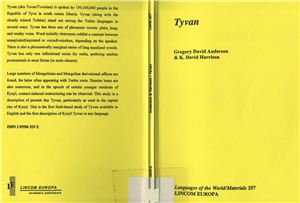Anderson G.D. , Harrison D. Tyvan. - Lincom Europa, 1999. - 97
p.
Tyvan (aka Tuvan/Tuvinian) is spoken by 150-200, 000 people in the Republic of Tyva in south centra Siberia. Tyvan (along with the closely related Tofalar) stand out among the Turkic languages in several ways. Tyvan has three sets of phonemic vowels: plain, long, and creaky voice. Word-initially obstruents exhibit a contrast between unaspirated/aspirated or voiced/voice less, depending on the speaker. There is also a phonemically marginal series of long nasalized vowels. Tyvan has only one inflectional series for verbs, prefering enclitic pronominals in most forms (in main clauses).
Large numbers of Mongolisms and Mongolian derivational affixes are found, the latter often appearing with Turkic roots. Russian loans are also numerous, and in the speech of certain younger residents of Kyzyl, contact-induced restructuring can be observed. This study is a description of present day Tyvan, particularly as used in the capital city of Kyzyl. This is the first field-based study of Tyvan available in English and the first description of Kyzyl Tyvan in any language.
ISBN 3 89586 529 X
Tyvan (aka Tuvan/Tuvinian) is spoken by 150-200, 000 people in the Republic of Tyva in south centra Siberia. Tyvan (along with the closely related Tofalar) stand out among the Turkic languages in several ways. Tyvan has three sets of phonemic vowels: plain, long, and creaky voice. Word-initially obstruents exhibit a contrast between unaspirated/aspirated or voiced/voice less, depending on the speaker. There is also a phonemically marginal series of long nasalized vowels. Tyvan has only one inflectional series for verbs, prefering enclitic pronominals in most forms (in main clauses).
Large numbers of Mongolisms and Mongolian derivational affixes are found, the latter often appearing with Turkic roots. Russian loans are also numerous, and in the speech of certain younger residents of Kyzyl, contact-induced restructuring can be observed. This study is a description of present day Tyvan, particularly as used in the capital city of Kyzyl. This is the first field-based study of Tyvan available in English and the first description of Kyzyl Tyvan in any language.
ISBN 3 89586 529 X

